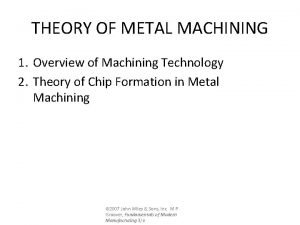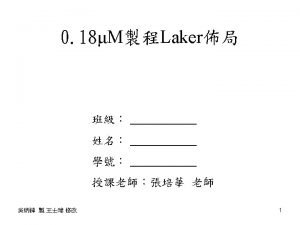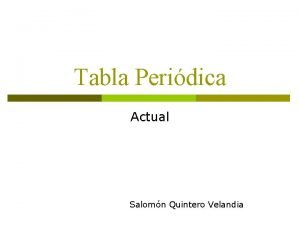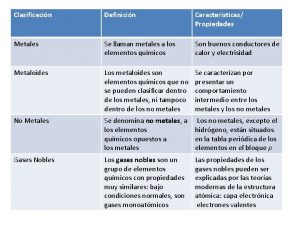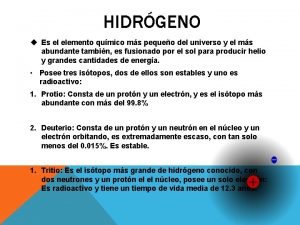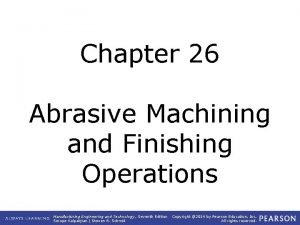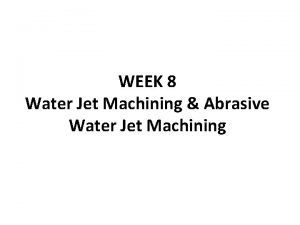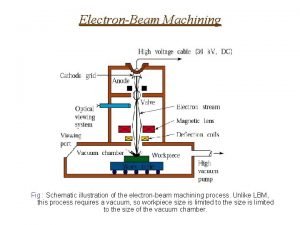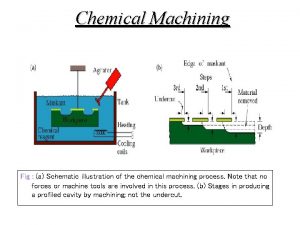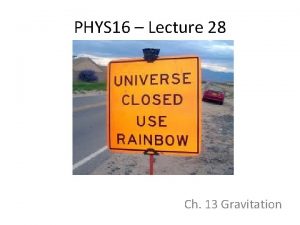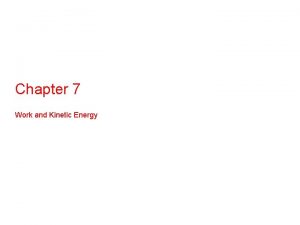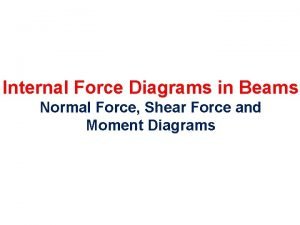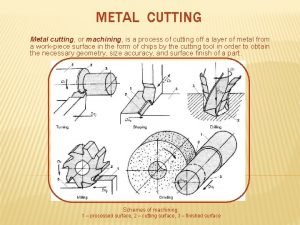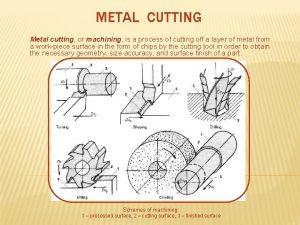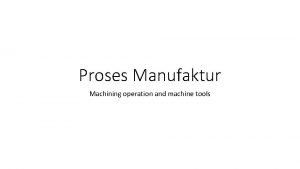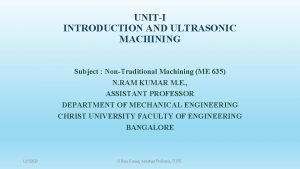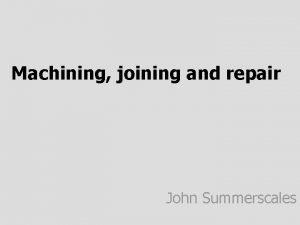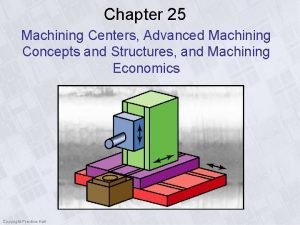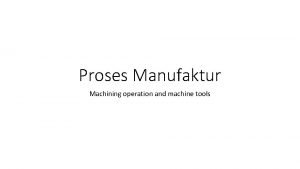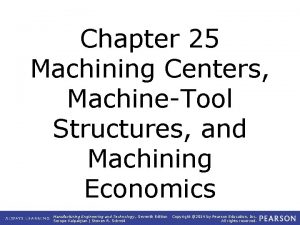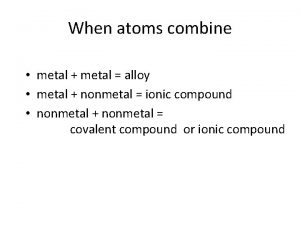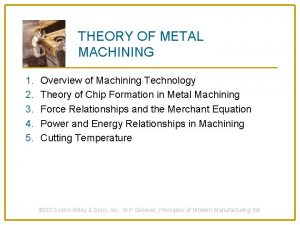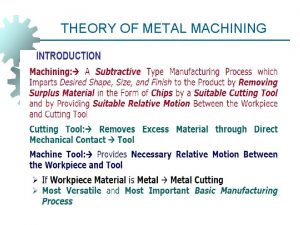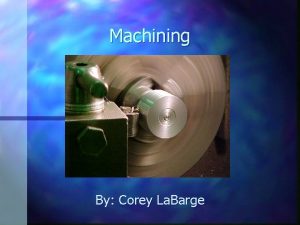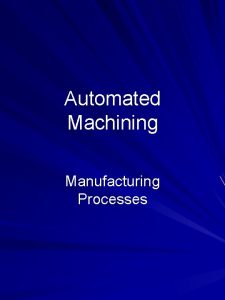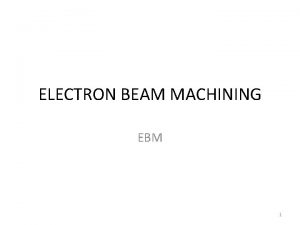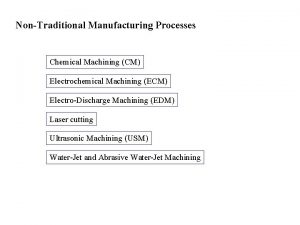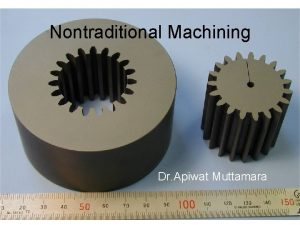THEORY OF METAL MACHINING 1 Force Relationships and




















- Slides: 20

THEORY OF METAL MACHINING 1. Force Relationships and the Merchant Equation 2. Cutting Temperature © 2007 John Wiley & Sons, Inc. M P Groover, Fundamentals of Modern Manufacturing 3/e

Chip Formation Figure 21. 8 More realistic view of chip formation, showing shear zone rather than shear plane. Also shown is the secondary shear zone resulting from tool‑chip friction. © 2007 John Wiley & Sons, Inc. M P Groover, Fundamentals of Modern Manufacturing 3/e

Four Basic Types of Chip in Machining 1. 2. 3. 4. Discontinuous chip Continuous chip with Built-up Edge (BUE) Serrated chip © 2007 John Wiley & Sons, Inc. M P Groover, Fundamentals of Modern Manufacturing 3/e

Discontinuous Chip § Brittle work materials § Low cutting speeds § Large feed and depth of cut § High tool‑chip friction Figure 21. 9 Four types of chip formation in metal cutting: (a) discontinuous © 2007 John Wiley & Sons, Inc. M P Groover, Fundamentals of Modern Manufacturing 3/e

Continuous Chip § Ductile work materials § High cutting speeds § Small feeds and depths § Sharp cutting edge § Low tool‑chip friction Figure 21. 9 (b) continuous © 2007 John Wiley & Sons, Inc. M P Groover, Fundamentals of Modern Manufacturing 3/e

Continuous with BUE § Ductile materials § Low‑to‑medium cutting speeds § Tool-chip friction causes portions of chip to adhere to rake face § BUE forms, then breaks off, cyclically Figure 21. 9 (c) continuous with built‑up edge © 2007 John Wiley & Sons, Inc. M P Groover, Fundamentals of Modern Manufacturing 3/e

Serrated Chip § Semicontinuous saw-tooth appearance § Cyclical chip forms with alternating high shear strain then low shear strain § Associated with difficult-to-machine metals at high cutting speeds Figure 21. 9 (d) serrated. © 2007 John Wiley & Sons, Inc. M P Groover, Fundamentals of Modern Manufacturing 3/e

Forces Acting on Chip § Friction force F and Normal force to friction N § Shear force Fs and Normal force to shear Fn Figure 21. 10 Forces in metal cutting: (a) forces acting on the chip in orthogonal cutting © 2007 John Wiley & Sons, Inc. M P Groover, Fundamentals of Modern Manufacturing 3/e

Resultant Forces § Vector addition of F and N = resultant R § Vector addition of Fs and Fn = resultant R' § Forces acting on the chip must be in balance: § R' must be equal in magnitude to R § R’ must be opposite in direction to R § R’ must be collinear with R © 2007 John Wiley & Sons, Inc. M P Groover, Fundamentals of Modern Manufacturing 3/e

Coefficient of Friction Coefficient of friction between tool and chip: Friction angle related to coefficient of friction as follows: © 2007 John Wiley & Sons, Inc. M P Groover, Fundamentals of Modern Manufacturing 3/e

Shear Stress Shear stress acting along the shear plane: where As = area of the shear plane Shear stress = shear strength of work material during cutting © 2007 John Wiley & Sons, Inc. M P Groover, Fundamentals of Modern Manufacturing 3/e

Cutting Force and Thrust Force § F, N, Fs, and Fn cannot be directly measured § Forces acting on the tool that can be measured: § Cutting force Fc and Thrust force Ft Figure 21. 10 Forces in metal cutting: (b) forces acting on the tool that can be measured © 2007 John Wiley & Sons, Inc. M P Groover, Fundamentals of Modern Manufacturing 3/e

Forces in Metal Cutting § Equations can be derived to relate the forces that cannot be measured to the forces that can be measured: F = Fc sin + Ft cos N = Fc cos ‑ Ft sin Fs = Fc cos ‑ Ft sin Fn = Fc sin + Ft cos § Based on these calculated force, shear stress and coefficient of friction can be determined © 2007 John Wiley & Sons, Inc. M P Groover, Fundamentals of Modern Manufacturing 3/e

The Merchant Equation § Of all the possible angles at which shear deformation can occur, the work material will select a shear plane angle that minimizes energy, given by § Derived by Eugene Merchant § Based on orthogonal cutting, but validity extends to 3 -D machining © 2007 John Wiley & Sons, Inc. M P Groover, Fundamentals of Modern Manufacturing 3/e

What the Merchant Equation Tells Us § To increase shear plane angle § Increase the rake angle § Reduce the friction angle (or coefficient of friction) © 2007 John Wiley & Sons, Inc. M P Groover, Fundamentals of Modern Manufacturing 3/e

Effect of Higher Shear Plane Angle § Higher shear plane angle means smaller shear plane which means lower shear force, cutting forces, power, and temperature Figure 21. 12 Effect of shear plane angle : (a) higher with a resulting lower shear plane area; (b) smaller with a corresponding larger shear plane area. Note that the rake angle is larger in (a), which tends to increase shear angle according to the Merchant equation © 2007 John Wiley & Sons, Inc. M P Groover, Fundamentals of Modern Manufacturing 3/e

Cutting Temperature § Approximately 98% of the energy in machining is converted into heat § This can cause temperatures to be very high at the tool‑chip § The remaining energy (about 2%) is retained as elastic energy in the chip © 2007 John Wiley & Sons, Inc. M P Groover, Fundamentals of Modern Manufacturing 3/e

Cutting Temperatures are Important High cutting temperatures 1. Reduce tool life 2. Produce hot chips that pose safety hazards to the machine operator 3. Can cause inaccuracies in part dimensions due to thermal expansion of work material © 2007 John Wiley & Sons, Inc. M P Groover, Fundamentals of Modern Manufacturing 3/e

Cutting Temperature § Analytical method derived by Nathan Cook from dimensional analysis using experimental data for various work materials where T = temperature rise at tool‑chip interface; U = specific energy; v = cutting speed; to = chip thickness before cut; C = volumetric specific heat of work material; K = thermal diffusivity of work material © 2007 John Wiley & Sons, Inc. M P Groover, Fundamentals of Modern Manufacturing 3/e

Thanks © 2007 John Wiley & Sons, Inc. M P Groover, Fundamentals of Modern Manufacturing 3/e
 Theory of metal machining
Theory of metal machining Difference between metal oxides and non metal oxides
Difference between metal oxides and non metal oxides Difference between metal oxides and non metal oxides
Difference between metal oxides and non metal oxides Use of non metals
Use of non metals Is sulfer a metal nonmetal or metalloid
Is sulfer a metal nonmetal or metalloid Dr terry blanch
Dr terry blanch Metal and non metal
Metal and non metal Metals vs nonmetals
Metals vs nonmetals Venn diagram of matter
Venn diagram of matter Pimp nimp
Pimp nimp When a metal reacts with a nonmetal the metal will
When a metal reacts with a nonmetal the metal will Grupo b tabla periódica
Grupo b tabla periódica Clasificación de los metales y no metales
Clasificación de los metales y no metales El sodio es metal o no metal
El sodio es metal o no metal Abrasive manufacturing process
Abrasive manufacturing process Application of water jet machining
Application of water jet machining Advantages and disadvantages of electron beam machining
Advantages and disadvantages of electron beam machining Electrochemical machining advantages and disadvantages
Electrochemical machining advantages and disadvantages Centripetal force and gravitational force
Centripetal force and gravitational force Hooke's law vector form
Hooke's law vector form Normal force and shear force
Normal force and shear force
